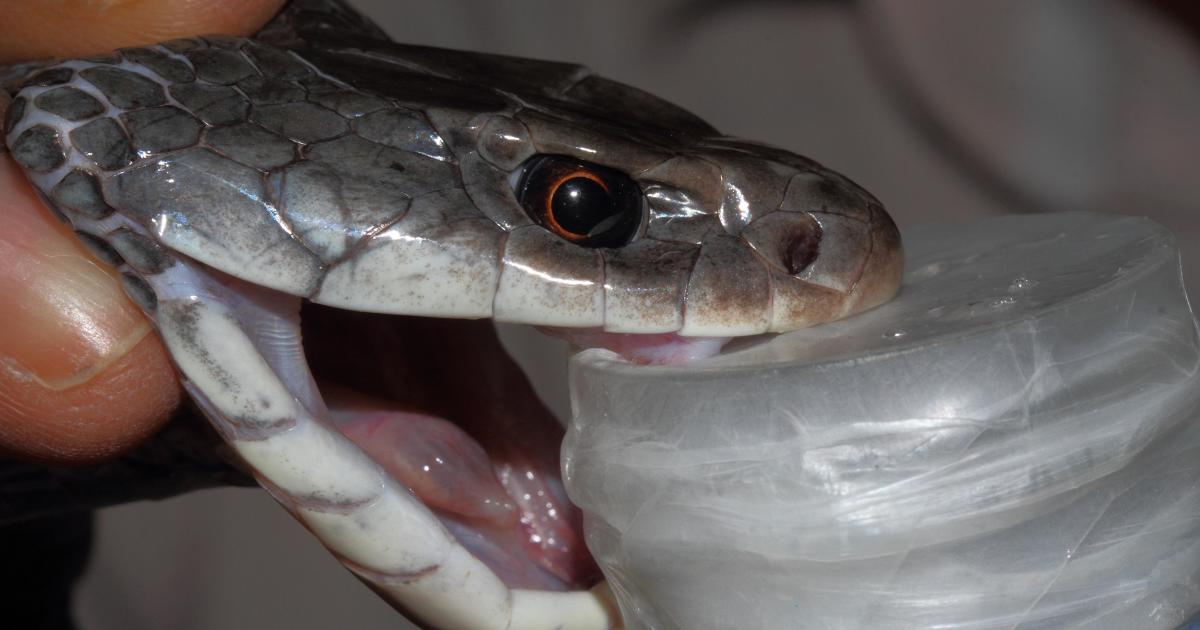Tim Friede was feeling particularly down on the day after the September 11 attacks, so he went to his basement and let two of the world’s deadliest snakes bite him.
\u200e
\u200eFour days later, he woke up from a coma.
\u200e
\u200e”I know what it feels like to die from snakebite,” Friede told AFP via video call from his home in the small US town of Two Rivers, Wisconsin.
\u200e
\u200eThis experience might put most people off snakes entirely, but Friede simply vowed to be more careful next time.
\u200e
\u200eFrom 2000 to 2018, he allowed himself to be bitten by snakes more than 200 times. He also injected himself with their venom over 650 times.
\u200e
\u200eFriede endured this pain because he wanted to achieve total immunity to venom, a practice called mithridatism, which should not be tried at home.
\u200e
\u200eAfter a couple of years, Friede started to believe he could be the basis for a better kind of antivenom. The former truck mechanic, who does not have a university degree, long struggled to be taken seriously by scientists.
\u200e
\u200eBut last month, a study published in the prestigious Cell journal showed that antibodies from his blood protect against a range of snake venom.
\u200e
\u200eThe researchers now hope Friede’s hyper-immunity could even lead to the development of a universal antivenom.
\u200e
\u200eThis would fill a major need, because currently most antivenoms only cover one or a few of the world’s 600 venomous snakes.
\u200e
\u200eUp to 138,000 people are killed by snakebites a year, while 400,000 suffer amputations or other disabilities, according to the World Health Organisation.
\u200e
\u200eThese figures are believed to be vastly underestimated because snakebite victims typically live in poorer, remote areas.
\u200e
\u200e- ‘Pain every time’ –
\u200e
\u200eFriede’s first bite was from a harmless garter snake when he was five years old.
\u200e
\u200e”I was afraid, I cried, I ran away,” said Friede, now 57.
\u200e
\u200eThen he started bringing snakes home and hiding them in pickle jars. His mother sought counselling, but his interest in snakes persisted.
\u200e
\u200eThings escalated after Friede attended a class that taught him how to “milk” snakes for their venom.
\u200e
\u200eHow antivenom is made has changed little over the last 125 years.
\u200e
\u200eSmall doses of snake venom are injected into animals such as horses, which produce antibodies that can be extracted and used as antivenom.
\u200e
\u200eHowever this antivenom usually only works for bites from that particular species of snake — and it includes other antibodies from horse that can cause serious side-effects including anaphylactic shock.
\u200e
\u200e”I thought, well, if they make antivenom in horses, why can’t I just use myself as a primate?” Friede said.
\u200e
\u200eHe started working through the venom from all the deadly species he could get his hands on, such as cobras, taipans, black mambas and rattlesnakes.
\u200e
\u200e”There is pain every time,” he said.
\u200e
\u200e- ‘Proud’ –
\u200e
\u200eFor years, the scientists he contacted to take advantage of his immunity refused to bite.
\u200e
\u200eThen in 2017, immunologist Jacob Glanville, who previously worked on universal vaccines, turned his attention towards antivenom.
\u200e
\u200eGlanville told AFP he had been looking for “a clumsy snake researcher who’d been bit accidentally a couple times,” when he came across a video of Friede taking brutal back-to-back snake bites.
\u200e
\u200eWhen they first spoke, Glanville said he told Friede: “I know this is awkward, but I would love to get my hands on some of your blood.”
\u200e
\u200e”I’ve been waiting for this call for a long time,” came the response, Glanville said.
\u200e
\u200eThe antivenom described in the Cell paper includes two antibodies from Friede’s blood, as well as a drug called varespladib.
\u200e
\u200eIt offered mice full protection against 13 of the 19 snake species tested, and partial protection for the remaining six.
\u200e
\u200eThe researchers hope a future cocktail will cover far more snakes — particularly vipers — with further trials planned on dogs in Australia.
\u200e
\u200eTimothy Jackson of the Australian Venom Research Unit praised the immunological research, but questioned whether a human needed to be involved, pointing to synthetically developed antibodies.
\u200e
\u200eGlanville said the ultimate goal of his US-based firm Centivax was to develop a universal antivenom administered by something like an EpiPen, potentially produced in India to keep the costs down.
\u200e
\u200eFriede said he was “proud” to have made a “small difference” in medical history.
\u200e
\u200eNow working for Centivax, Friede stopped self-inflicting himself with venom in 2018 to save the firm from liability issues.
\u200e
\u200eBut he hopes to get bitten by snakes again in the future.
\u200e
\u200e”I do miss it,” he said.
\u200e
\u200eAFP
Provided by SyndiGate Media Inc. (
Syndigate.info
).







